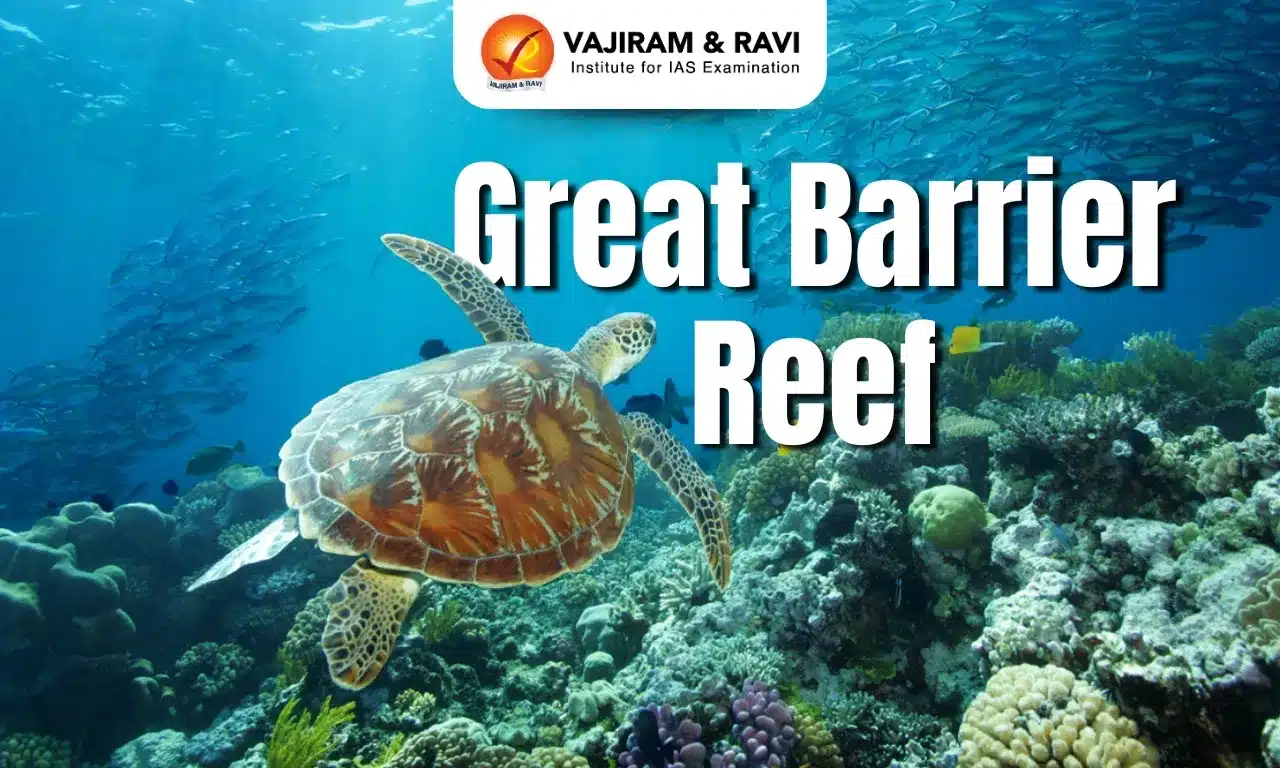Great Barrier Reef Latest News
The Great Barrier Reef has recorded its steepest decline in hard coral cover in almost four decades, as climate change-induced heat stress, cyclones and outbreaks of coral-eating starfish drive the ecosystem to the brink.
About Great Barrier Reef
- It is a complex of coral reefs, shoals, and islets in the Pacific Ocean off the northeastern coast of Australia in the Coral Sea.
- It is the longest and largest reef complex in the world and is the largest living structure on Earth.
- It extends in roughly a northwest-southeast direction for more than 2,000 km, at an offshore distance ranging from 16 to 160 km, and its width ranges from 60 to 250 km.
- It has an area of some 350,000 sq.km. It makes up about 10 percent of the world’s coral reef ecosystems.
- The reef, which is large enough to be visible from space, actually consists of some 2,100 individual reefs and some 800 fringing reefs (formed around islands or bordering coastlines).
- It contains 400 types of coral, 1,500 species of fishes, and 4,000 types of mollusks species.
- The reef is also home to six of the seven known species of sea turtles, more than a dozen sea snakes, and nearly two dozen species of birds.
- It also holds great scientific interest as the habitat of species such as the dugong (‘sea cow’) and the large green turtle, which are threatened with extinction.
- Much of the Great Barrier Reef is a marine protected area, managed by the Great Barrier Reef Marine Park Authority of Australia.
- UNESCO declared the Great Barrier Reef a World Heritage Site in 1981.
Source: DTE
Last updated on November, 2025
→ Check out the latest UPSC Syllabus 2026 here.
→ Join Vajiram & Ravi’s Interview Guidance Programme for expert help to crack your final UPSC stage.
→ UPSC Mains Result 2025 is now out.
→ UPSC Notification 2026 is scheduled to be released on January 14, 2026.
→ UPSC Calendar 2026 is released on 15th May, 2025.
→ The UPSC Vacancy 2025 were released 1129, out of which 979 were for UPSC CSE and remaining 150 are for UPSC IFoS.
→ UPSC Prelims 2026 will be conducted on 24th May, 2026 & UPSC Mains 2026 will be conducted on 21st August 2026.
→ The UPSC Selection Process is of 3 stages-Prelims, Mains and Interview.
→ UPSC Result 2024 is released with latest UPSC Marksheet 2024. Check Now!
→ UPSC Prelims Result 2025 is out now for the CSE held on 25 May 2025.
→ UPSC Toppers List 2024 is released now. Shakti Dubey is UPSC AIR 1 2024 Topper.
→ UPSC Prelims Question Paper 2025 and Unofficial Prelims Answer Key 2025 are available now.
→ UPSC Mains Question Paper 2025 is out for Essay, GS 1, 2, 3 & GS 4.
→ UPSC Mains Indian Language Question Paper 2025 is now out.
→ UPSC Mains Optional Question Paper 2025 is now out.
→ Also check Best IAS Coaching in Delhi
Great Barrier Reef FAQs
Q1. Where is the Great Barrier Reef located?+
Q2. Approximately how long is the Great Barrier Reef?+
Q3. What is the approximate total area of the Great Barrier Reef?+
Tags: great barrier reef prelims pointers upsc current affairs upsc prelims current affairs

















